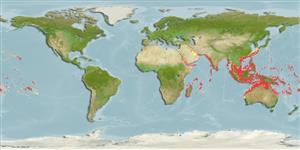Common names from other countries
>
Eupercaria/misc (Various families in series Eupercaria) >
Lethrinidae (Emperors or scavengers) > Monotaxinae
Etymology: Gymnocranius: Greek, gymnos = naked + Greek, kranion = skull (Ref. 45335).
More on author: Valenciennes.
Environment: milieu / climate zone / depth range / distribution range
Ecologia
marino associati a barriera corallina; non migratori; distribuzione batimetrica 20 - 170 m (Ref. 12260). Tropical; 35°N - 28°S, 32°E - 134°W
Indo-Pacific: East Africa to southeastern Oceania and from Australia northward to Japan. This species has been referred to as Gymnocranius robinsoni in recent literature.
Size / Peso / Age
Maturity: Lm ? range ? - ? cm
Max length : 80.0 cm TL maschio/sesso non determinato; (Ref. 2295); common length : 64.0 cm SL maschio/sesso non determinato; (Ref. 37816); peso massimo pubblicato: 5.5 kg (Ref. 40637)
Spine dorsali (totale) : 10; Raggi dorsali molli (totale) : 10; Spine anali: 3; Raggi anali molli: 10.
Inhabits offshore reefs (Ref. 9710), trawling grounds of the continental shelves and offshore rocky bottoms (Ref. 30573). Juveniles inshore on muddy substrates (Ref. 48635). Solitary or in small groups (Ref. 90102). Feeds mostly on bottom invertebrates and small fishes (Ref. 30573). Potential commercial fish if sufficient stocks can be located (Ref. 9775). Marketed fresh (Ref. 9775); sometimes with a strong and unpleasant flavor (Ref. 11888).
Life cycle and mating behavior
Maturities | Riproduzione | Spawnings | Egg(s) | Fecundities | Larve
Carpenter, K.E. and G.R. Allen, 1989. FAO Species Catalogue. Vol. 9. Emperor fishes and large-eye breams of the world (family Lethrinidae). An annotated and illustrated catalogue of lethrinid species known to date. FAO Fish. Synop. 125(9):118 p. Rome: FAO. (Ref. 2295)
IUCN Red List Status (Ref. 130435)
CITES (Ref. 128078)
Not Evaluated
Threat to humans
Harmless
Human uses
Pesca: scarso interesse commerciale
Strumenti
Special reports
Download XML
Fonti Internet
Estimates based on models
Preferred temperature (Ref.
115969): 21.6 - 28.3, mean 26.8 (based on 971 cells).
Phylogenetic diversity index (Ref.
82804): PD
50 = 0.5010 [Uniqueness, from 0.5 = low to 2.0 = high].
Bayesian length-weight: a=0.02042 (0.01172 - 0.03557), b=2.88 (2.73 - 3.03), in cm Total Length, based on LWR estimates for this species & (Sub)family-body (Ref.
93245).
Trophic level (Ref.
69278): 3.8 ±0.0 se; based on diet studies.
Resilienza (Ref.
120179): Medio, tempo minimo di raddoppiamento della popolazione 1.4 - 4.4 anni (K=0.23).
Fishing Vulnerability (Ref.
59153): Moderate vulnerability (42 of 100).
